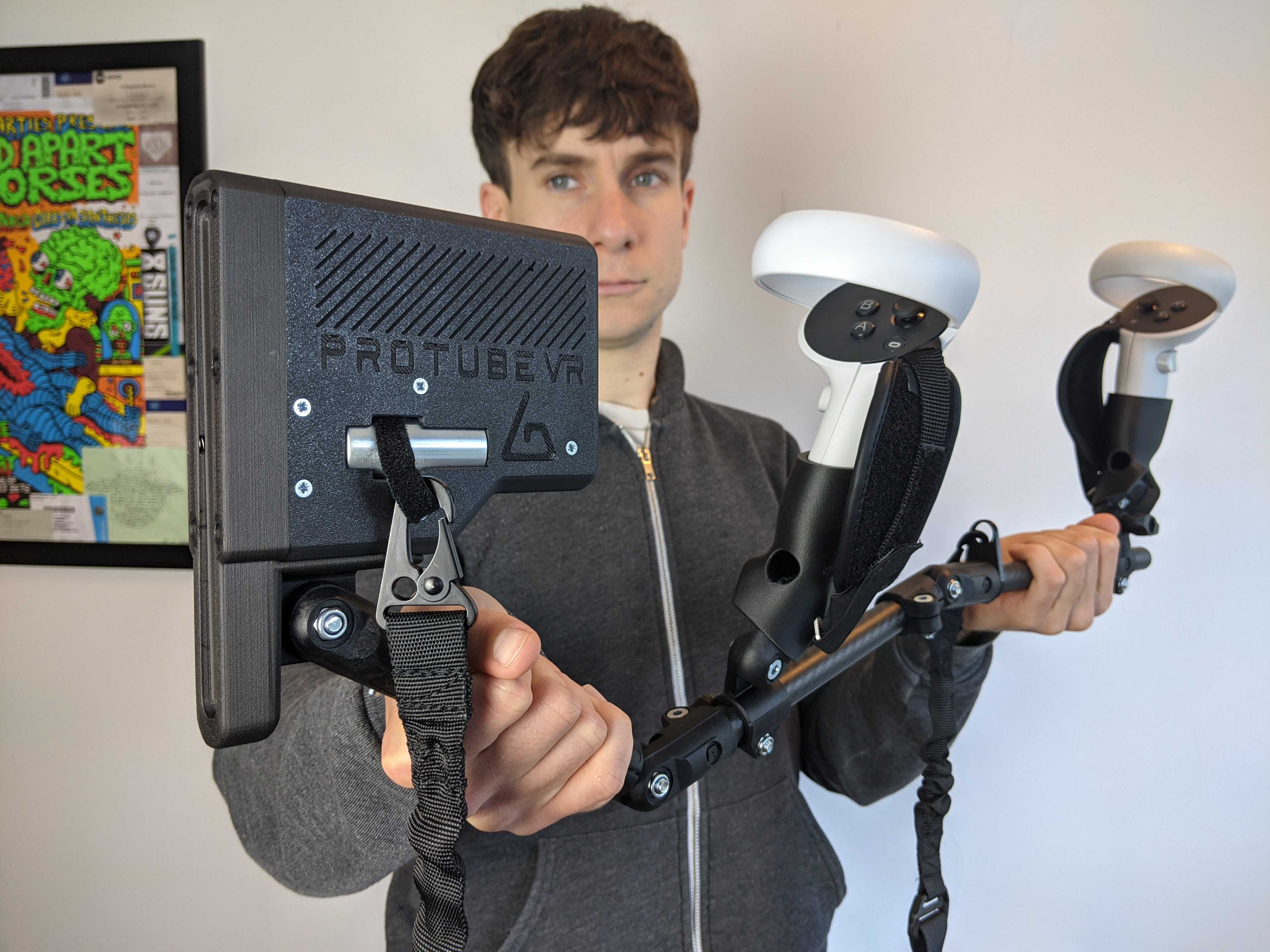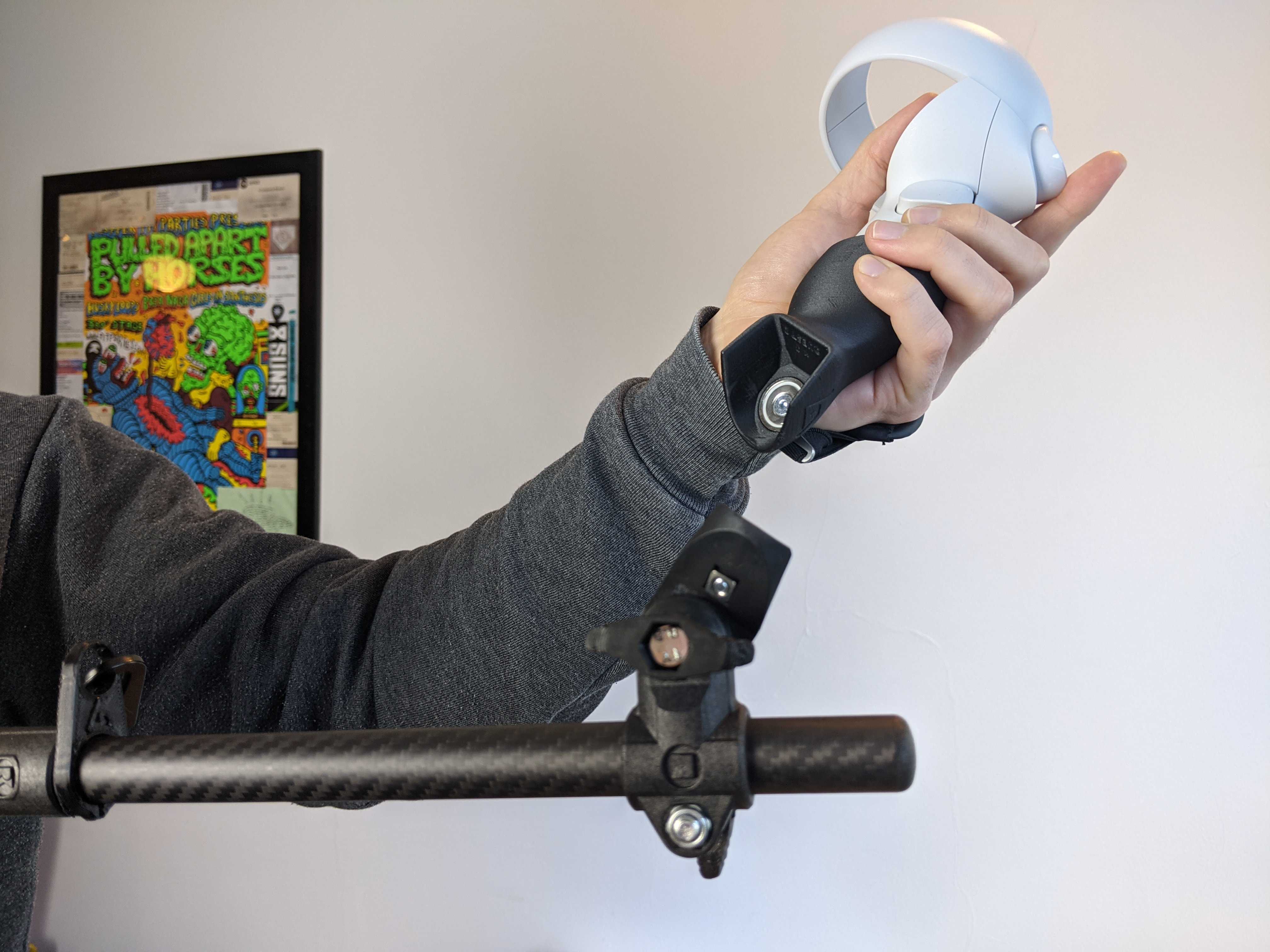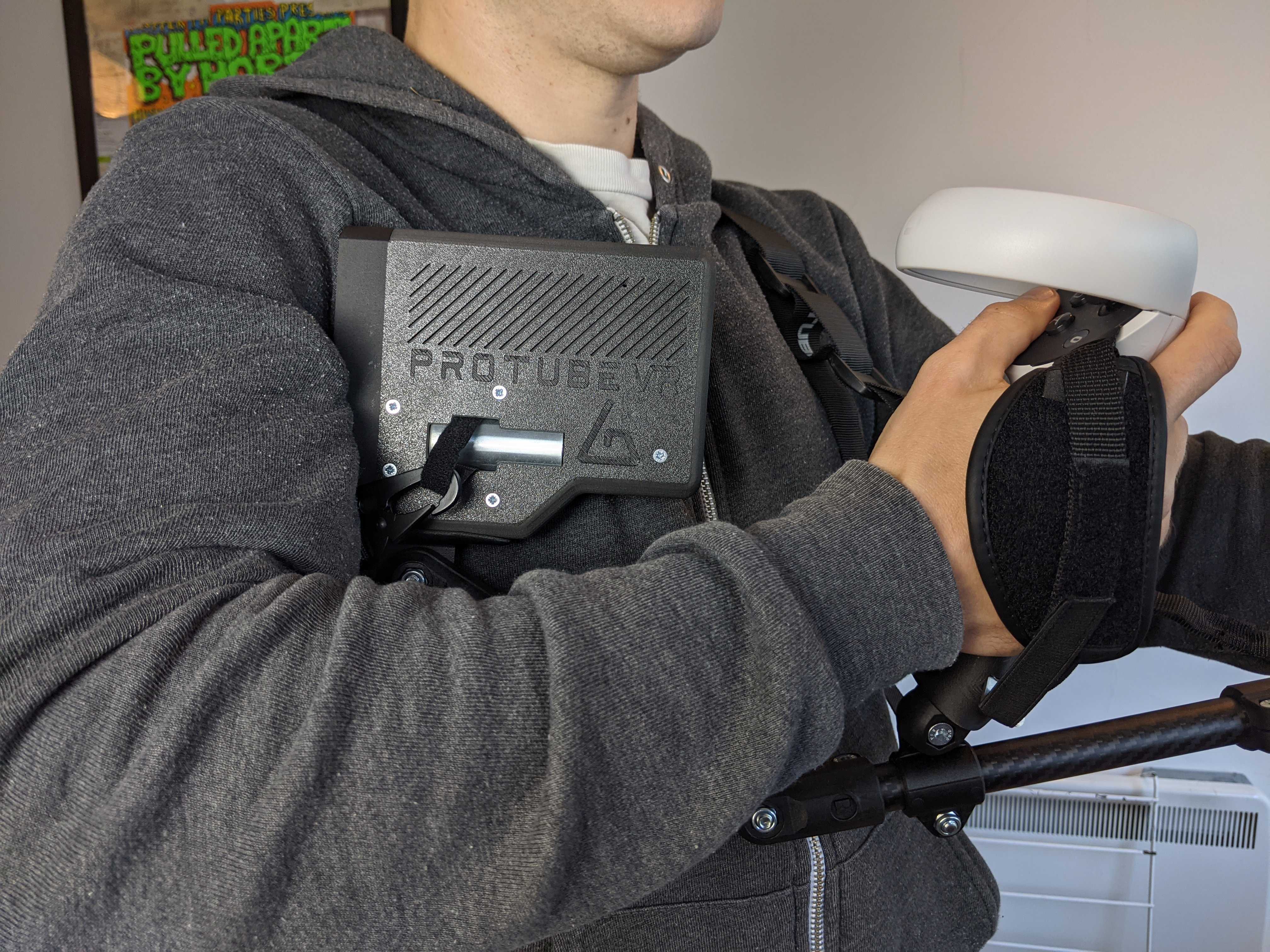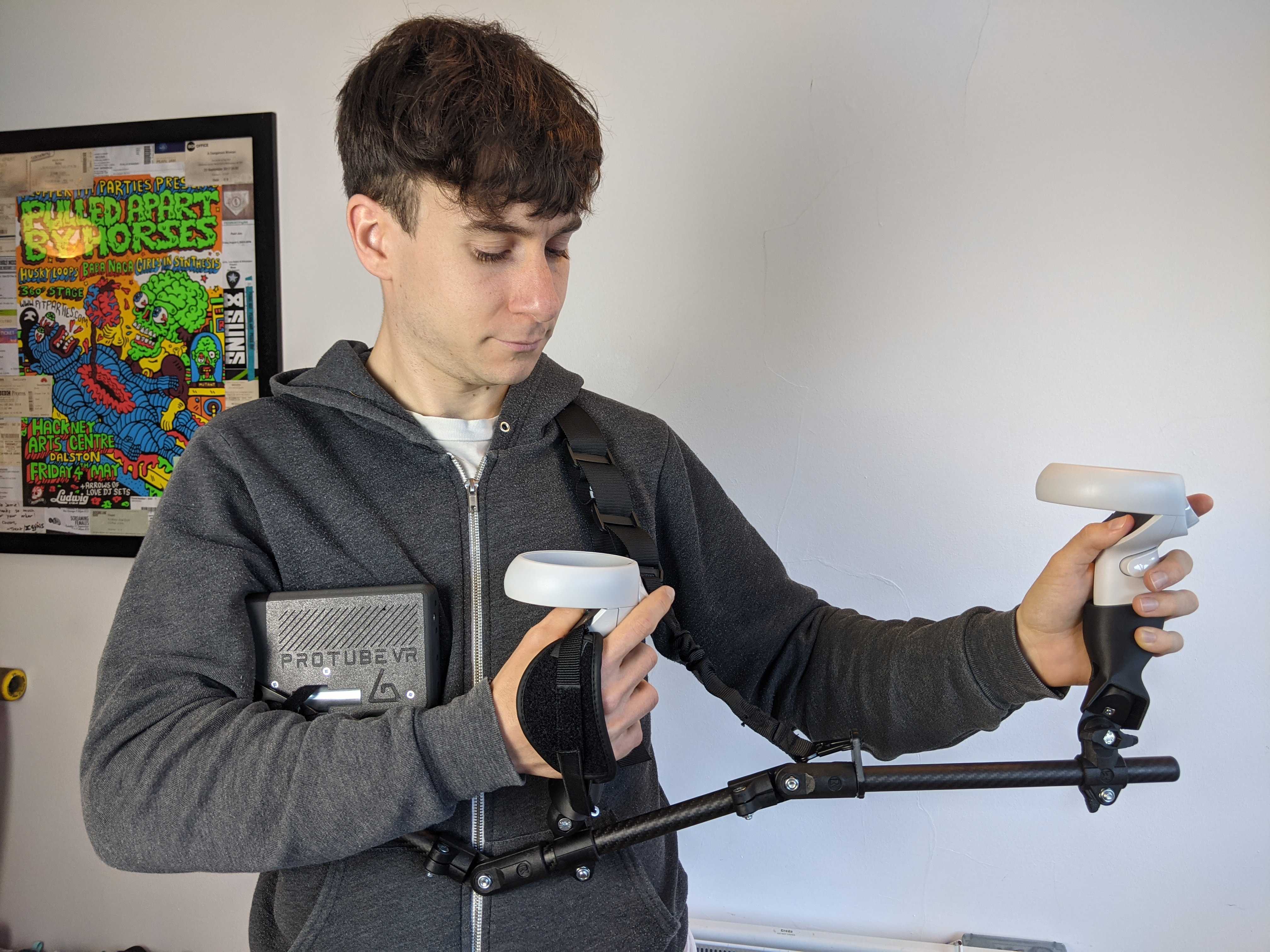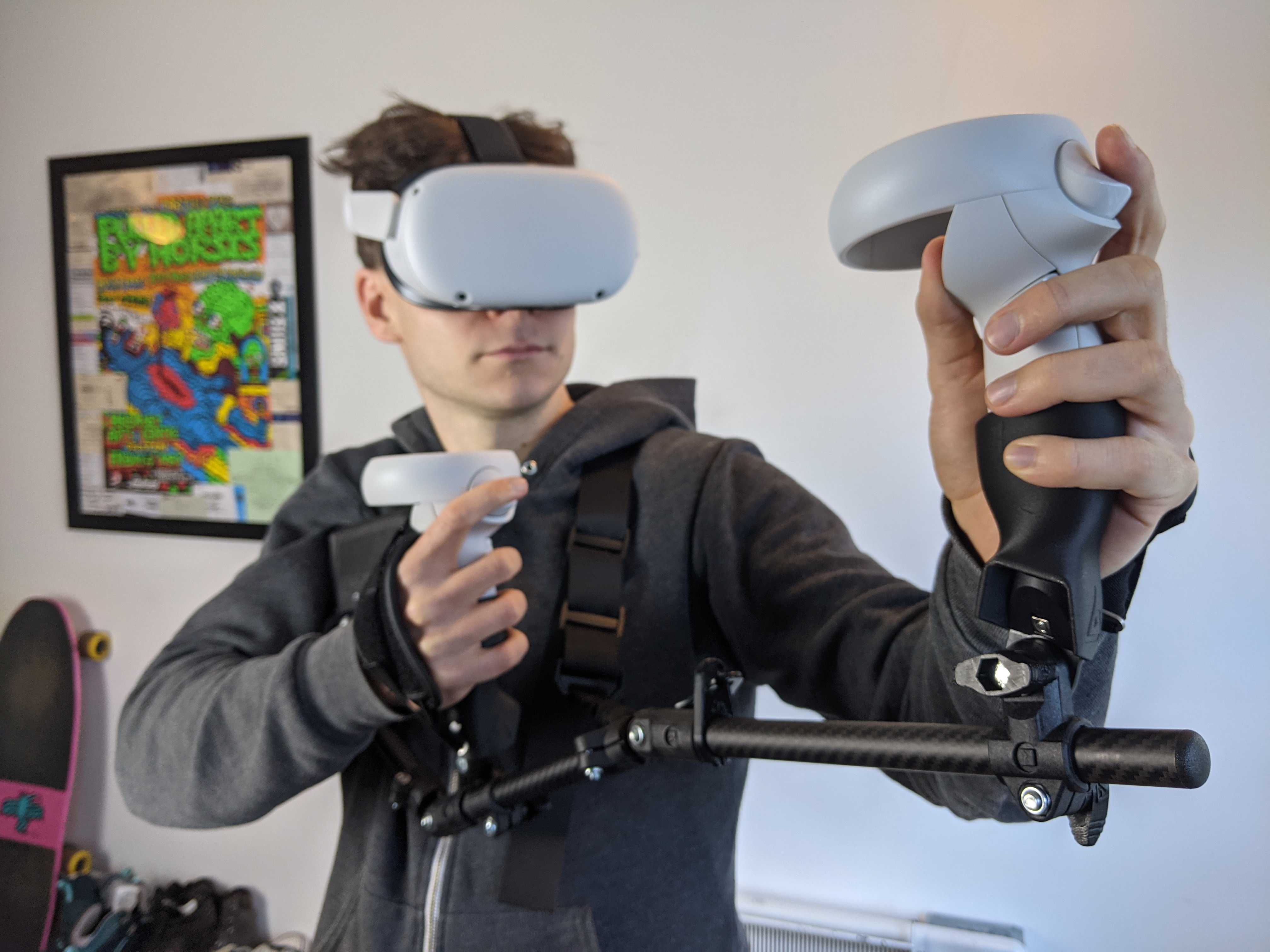The new ForceTube makes meaningful upgrades and offers a novel experience, but clunky setup and steep pricing means it’s only for the most dedicated of VR shooter fans. Read on for our ForceTube review.
Protube has been around for some time, making magnetic rifle stocks for basically every VR headset in recent memory. The idea for its core MagTube product is sound – an adjustable set of tubes you can fit to your liking, with VR controllers sitting on top in detachable cups to simulate holding a rifle. Whilst PSVR has the excellent Aim Controller, for PC VR and Quest headsets this is the only alternative to pretending to hold a gun with two hands which, let’s admit, has always felt a little silly.
But the company’s newly-updated ForceTube model goes beyond even that, adding a haptic module on the back of the device that you’ll rest your shoulder on. Pull the trigger in a compatible game and it will jolt to simulate the experience. Again, the idea is great on paper and I suspect VR’s most devoted shooter fans will really enjoy the added immersion, but this incredibly expensive peripheral, priced at €395, is far too much of a hassle to recommend to everyone.
Design
In its base form, the ForceTube (and, by extension, MagTube) works well. There are three adjustable bolts that need tightening and loosening with an included Allen key so you can get the right fit and make sure it stays there. The controller cups can also slide up and down the kit using the same process. It does, however, mean that adjusting the stock takes a lot of effort, which is especially annoying when trying to fine-tune your grip during first setup. ForceTube might seem like a great idea to show friends at VR parties, but everyone will have to adjust to your grip unless you want to spend 20 minutes fiddling with its more bitty parts every time you swap the headset.
Once you are up and running, though, ForceTube feels great in a lot of games. Raising a rifle scope to my eye in Sniper Elite VR was powerfully immersive, as was wielding shotguns and machine guns in other levels. That said, while this certainly feels better than simply imitating holding a two-handed firearm, the bottom-heavy setup leaves a lot of room for improvement. You’d hold a real gun from below, so it’s a little strange to have all the weight under your hands here. I’d definitely like to see a future design that tried to work around this problem, as complicated as it may be. Some of the 3D printed elements of the stock also feel a little cheap and one non-essential part even snapped in shipping.
In fact, the overall device doesn’t look especially attractive; more like some leftover materials from a DIY session that you’ve cobbled together. If you’re a shooter enthusiast that probably doesn’t matter too much to you, though. The haptic module’s plastic, meanwhile, seems flimsy and not reflective of the steep €395 price point.
All the same, there are some really ingenious factors to ForceTube’s design. The controller cups are held in place with magnets, making it easy to quickly break away from the stock with one hand when you need to pick something up, push a button or throw a grenade. You also get a strap so you can take both hands off and dangle the stock (which is unavoidably uncomfortable) when need be. And resting the haptic module into your shoulder really adds an element that’s been missing from a lot of VR shooters, even PSVR titles that support the Aim controller.
Fans of the first ForceTube will be happy to know this redesign is smaller and lighter than the original, while still promising to pack the same punch. It’s still a heavy device, though, weighing in at 1.2kg when paired with the gunstock. That will no doubt limit how long the controller feels comfortable to hold; I could manage about 10 to 15 minutes of play before my arms started to feel tired and burying the haptic module in my shoulder also started to feel quite painful after a little bit. Again, though, you can always rest your arms and dangle the stock for a while.
Haptics
But what about the sensation the haptics themselves provide? Well, obviously, the ForceTube doesn’t deliver the powerful kick of, say, a shotgun when you fire your weapon. Putting the force of an actual weapon in there would be a bit overkill. Instead, you’ll get a very noticeable push more akin to the recoil of a paintball gun. I wouldn’t say it provides an incredibly authentic experience, but the extra kick does give you at least a little more of a sensation of being inside the game.
I’ve been enjoying ForceTube most with fast-firing machine guns. It really adds an extra dimension to feel the rattle when you squeeze the trigger. The haptics are localized to the back of the unit, so you won’t really feel the shake too much in your hands and it makes less of an impact with single-shot rifles and shotguns. Of course, how much you enjoy the experience will depend on how well it’s implemented into the given game. Sniper Elite helpfully lets you streamline controls as much as you see fit, so you don’t need to worry about colliding with the stock when taking your hand away to reload.
Another big caveat is that the thing is noisy. Like, really noisy. Every squeeze of the trigger results in a very audible clank that sounds more like I’m using a nail gun to assemble a set of shelves than it does anything else. That’s definitely worth noting if you don’t want to be disturbing neighbors or even just other people in your house. I’ve noticed a few bugs too; in Contractors the module started responding to when my enemies fired their weapons, for example.
Compatibility And User Experience
As tricky as some elements of the ForceTube can be, I’d have had an easier time using the kit if there was a better set of instructions and tutorials included. The unit I was given was actually pre-assembled (which the company says they do only for media), but I still needed to get to grips for adjusting the kit which took a while to figure out. But, if you do have to set it up, you’ll have an incredibly long list to clear through. The entire thing comes deconstructed and ProTube says it takes around 90 minutes to set the kit up. There are at least video tutorials, though they’re hidden away on the company’s YouTube channel and it’s not easy to find them on the official website.
The website also has a list of compatible games but only hidden away on the store page for each product and in a PDF document. It’d be nicer to have a more accessible, regularly updated list of games to reference. Overall ProTube could really do with streamlining its support system to give you faster access to better instructions. Either that or ship the product already assembled to give customers less of an initial headache. That said the Bluetooth connection on Quest was very easy to set up and had me ready to go in minutes once I enabled support in the games I tested.
Currently, the actual list of compatible games is quite small, but there are some big titles compatible on both PC and Oculus Quest. Those include Onward, Contractors and Sniper Elite VR on both platforms, and PC players also get Pavlov and Hot Dogs, Horseshoes & Hand Grenades among others.
Those multiplayer titles are crucial to giving ProTube some longevity, but it’s definitely a shame not to see native support for games like Boneworks, Medal of Honor: Above and Beyond and The Walking Dead: Saints & Sinners. Getting support for third-party peripherals not officially endorsed by platform holders themselves must be tough but, when ForceTube costs an eye-watering €395, it’s tough not to see the handful of games included right now as lacking.
With that said, you can implement your own support into PC titles using the company’s companion app. ProTube has its own software to edit bindings and haptic feedback which, again, is a really excellent feature for enthusiasts looking to fine-tune the realism they get from VR. As with other elements, though, actually setting all of this up takes multiple, complicated steps and once again underscores how the ForceTube is really only for the people that have the patience (and money) to improve their VR shooter setup.
ForceTube Review – Final Impressions
ProTube’s ForceTube update offers some meaningful improvements on the original design, but the device will really only appeal to the most devoted of VR shooter fans that will stop at nothing to get the most immersive experience. Though it’s far from authentic, the haptic sensation is a great novelty that adds a little punch to your shooter sessions, but it’s loud and proves uncomfortable to hold after a while, while limited compatibility makes the €395 all-in price a bitter pill to swallow.
PSVR’s Aim Controller may not have the haptic module or the shoulder stock but its universal size, integrated buttons and lightning-fast setup will make it a much more preferable option if you have that headset. But if no obstacle is too big to get as close to an immersive shooter experience as possible, then ForceTube is a fun, if entirely inessential addition to your arsenal. For anyone else, you’re better off to keep playing pretend for now.


